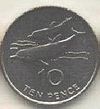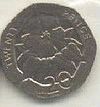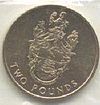- Coins of the Saint Helena pound
-
The islands of Saint Helena and Ascension, which are constituents of the British overseas territory of Saint Helena, Ascension and Tristan da Cunha, have their own currency, the Saint Helena pound, which is linked to the pound sterling. As a consequence, the government of St Helena mints its own coins. In 1976, the government began issuing notes, with circulation coins following in 1984. Prior to 1984, both St Helena and Ascension Island had issued commemorative coins but used British circulation coins.
Tristan da Cunha, the third part of the territory, uses Pound sterling rather than the St Helena pound. However there are occasionally commemorative coins minted for the island.[1]
Design
In 1984, the coins introduced were in denominations of 1, 2, 5, 10 and 50 pence and 1 pound. All the coins were the same size and composition as the corresponding British coins. 20 pence coins were introduced in 1998, followed by 2 pounds in 2002 (the design of which followed earlier commemorative 2 pound coins - shown below). The 2 pound coins became bi-metallic in 2003 and is now similar to the British Two Pound Coin. The edge inscriptions of the 2 pound coins are (in capitals) "500th Anniversary" for the 2002 coin and "Loyal and Faithful" for the 2003- coin.
All circulation coins have on the obverse side a portrait of the head of Queen Elizabeth II, "Queen Elizabeth II", "St. Helena • Ascension" and the year written. Many of the commemorative coins over the years however only have written either "St. Helena" or "Ascension Island".
Some of the coin reverse designs have changed since 1984. The five pence pieces issued prior to 1998 showed the Saint Helena Plover (the "Wirebird", which is the national bird of St Helena), whilst the ten pence coins issued prior to 1998 showed orchids. The following table shows the current designs:
Depiction of St Helena and Ascension coinage (reverse side) £ 0.01 £ 0.02 £ 0.05 Tuna Donkey with firewood "Jonathan the Giant Tortoise" £ 0.10 £ 0.20 £ 0.50 Dolphin Lily Green Sea Turtle £ 1.00 £ 2.00 Sooty Tern Coat of arms of Saint Helena External links
References
- ^ Tristan da Cunha Coins
Types of British coinage Falkland Islands · Gibraltar · Guernsey · Isle of Man · Jersey · St Helena and Ascension · United KingdomCategories:- Coins by country
- Economy of Saint Helena
- Saint Helenian society
- Ascension Island
- Coins of the United Kingdom
- Saint Helena stubs
- Coin stubs
Wikimedia Foundation. 2010.








